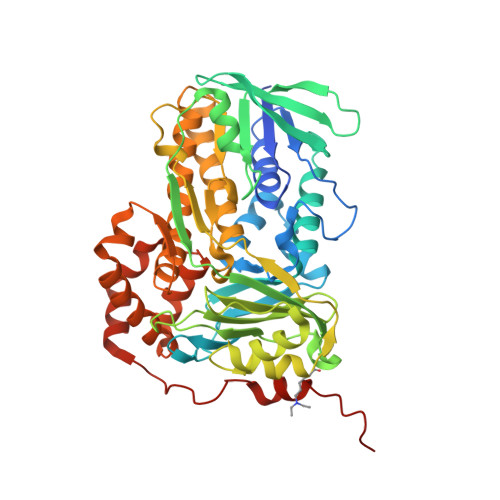Structural Basis of Sequential Enantioselective Epoxidation by a Flavin-Dependent Monooxygenase in Lasalocid A Biosynthesis.
Wang, Q., Deng, Y., Viera, D., Liu, X., Liu, N., Hu, Y., Hu, X., Wei, H., Zhou, Q., Lan, T., He, W., Chen, X., Kim, C.Y.(2025) Angew Chem Int Ed Engl 64: e202504982-e202504982
- PubMed: 40199722
- DOI: https://doi.org/10.1002/anie.202504982
- Primary Citation of Related Structures:
8UP4, 8XTZ, 8XU7 - PubMed Abstract:
Polyether polyketides are a structurally diverse group of natural products known for their antimicrobial and antiproliferative activities. Lasalocid A is a canonical natural polyether produced by the soil bacterium Streptomyces lasalocidi. In lasalocid A biosynthesis, a polyene polyketide intermediate is converted into a bisepoxide by the flavin-dependent monooxygenase enzyme Lsd18. Remarkably, Lsd18 acts on two distinct C═C groups in the substrate molecule, forming two (R,R) epoxides. We have determined the X-ray crystal structures of Lsd18 in the substrate-free, substrate-bound, and product-bound forms. Our work has revealed that Lsd18 has an extra-large substrate-binding pocket that allows the polyene to adopt different conformations within the enzyme pocket. This feature enables Lsd18 to epoxidate both of the C═C groups. Additionally, a subpocket located near the Lsd18 active site controls stereoselectivity by dictating which face of the C═C group is placed next to the flavin. Molecular understanding of how Lsd18 transforms a polyene into a bisepoxide during lasalocid A biosynthesis lays the foundation for the production of designer polyethers for drug development.
- Department of Chemistry and Biochemistry, The University of Texas at El Paso, El Paso, Texas, 79968, USA.
Organizational Affiliation:




















